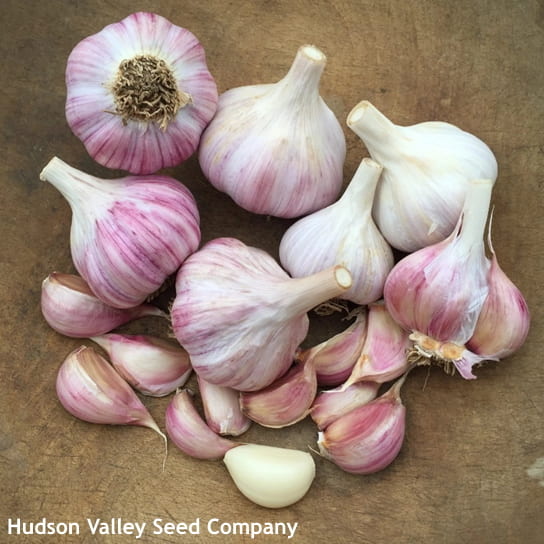Gordon Johnson, Extension Vegetable & Fruit Specialist; gcjohn@udel.edu
There is an increase in interest in growing garlic in our region and the time to plant garlic is in the fall. The following information is from the Mid-Atlantic Commercial Vegetable Production Recommendations.

Redskinned hardneck garlic.
Obtain the best strains of Italian or German “Rocambole” garlic (late or pink-skinned type), Polish softneck types that will braid (no hard seed stalk), or elephant types from a reputable agriculture products vendor or a local grower who has had success with fall-planted garlic. A locally grown strain will be hardy and may overwinter better than many commercially available strains. Avoid Creole garlics (also called Early, Louisiana, White Mexican, etc.), since they are not very winter-hardy and do not keep well. Bulbs of both Creole and Italian garlic have a white outer skin, but the Italian type has a pink skin around each clove. Elephant garlic (Allium ampeloprasum) is a type of leek that produces bulbils, is milder than regular garlic, and up to four times larger. However, Elephant garlic may not yield well when fall-planted in areas with severe cold or extensive freezing and thawing cycles, which cause heaving. The Italian and Elephant types take about 220 days to mature.
Many of the most productive Italian garlic strains will produce seed stalks prior to harvest. Snap these seed stalks just as they begin to coil for best yields. “Rocambole” types have coiled seed stalks that are perfectly normal and not the result of any poor cultural practice or herbicide contamination.
Garlic has a moderate nitrogen requirement (125 lbs/a total during the growing season) and higher phosphorus and potassium requirements (150 lbs/acre respectively).
Garlic cloves should be planted in early November on Delmarva. Growers should plant as late as possible to escape damage from the fall generation of the allium leafminer if present in the growing area. Yield tends to increase with the size of the mother bulb. Do not use the following for planting: long, slender cloves in the center of the bulb, cloves weighing less than 1 gram, or bulbs with side growths and very poor skin covering of cloves.
Garlic must be exposed to temperatures between 32-50°F (0-10°C) for about 2 months prior to the long daylength periods that induce bulbing. Fall-planted garlic establishes an excellent root system and receives a natural cold treatment that produces the highest possible garlic yields. Spring-planted garlic (e.g., Elephant type) may be successful where it can be planted by early March.
Cloves should be planted 4 by 4 inches apart in triple rows or multiple beds 16-18 inches apart. Between-row spacing depends on equipment available. Clove tops should be covered with 1-1½ inches of soil. Cloves must not be so deep that the soil will interfere with the growth of the bulbs, nor so shallow that rain, heaving from alternate freezing and thawing, and birds may dislodge them. Cloves placed with the root end down give optimum results. Cloves dropped into furrows will be in various positions and may produce plants with crooked necks.
Fall-planted garlic is ready for harvesting about the second week in July when 40-60% of the leaves have yellowed (garlic generally has 6 leaves). When plants reach this stage pull a sample. There are only about 10- 14 days for optimum harvest, when each clove is fully segmented and yet fully covered by a tight outer skin. Before the optimum harvest time, garlic is unsegmented like an onion. After the optimum time, cloves may have separated, the outer sheath split, and part of the naked cloves may be exposed. Run a cutter bar under the bulbs to cut the extensive root system and partially lift the bulbs. Bulbs can be pulled and gathered into windrows. Tops are placed uppermost in the windrow to protect bulbs from the sun. Garlic is left in the field for a week or more to dry or cure thoroughly. Curing can also be accomplished in a well-ventilated shed or barn. Use this option when rain is forecasted. Bulbs must be thoroughly dried before being shipped or stored. After curing, remove the outer loose portions of the sheath, and trim the roots close to the bulbs. Braid or bunch the tops together or cut off the tops and bag the bulbs like dry onions. Discard diseased and damaged bulbs.
When properly cured, garlic keeps well under a wide range of temperatures. Temporary storage in open-mesh sacks in a dry, well-ventilated storage room at 60-90°F is acceptable. However, storage at 32-35°F and 65% relative humidity (the same conditions as required for onions) is best. Avoid prolonged storage near 40°F to prevent sprouting of cloves. Avoid a relative humidity above 70% to prevent sprouting and development of mold.
Prefar is the only preplant/preemergence herbicide labeled.
Pests include the Allium leafminer, bloat nematode, and the diseases Botrytis leaf blight, downy mildew, Fusarium rot, purple blotch, and white rot. See the Mid-Atlantic Commercial Vegetable Production Recommendations for specific control recommendations.
